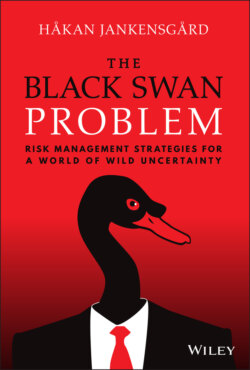Читать книгу The Black Swan Problem - Håkan Jankensgård - Страница 10
CHAPTER ONE The Swans Revisited
ОглавлениеTHE BLACK SWAN OF the popular imagination is one that swoops down from a clear blue sky, creating massive disorder in a very short amount of time. We expect it to be sudden and dramatic. The archetypical Black Swan is perhaps the 9/11 attack on the twin towers in New York in 2001. Virtually nobody could have been able to imagine such a thing. It was simply not on the mental map that something like that should even exist. Yet it happened, and in a single stroke, the world was a different place. The path we were on changed. The attack led to a whole new security apparatus, the war on terror, and the war in Iraq, to mention but a few of its consequences.
Actually, the ‘out of the blue’ aspect is not part of the original framework. Some Swans cited by Taleb take years if not centuries to play out. According to Taleb, Black Swans have just three attributes, none of which refers to suddenness. First, they are highly improbable. Second, they are highly consequential. Third, they make perfect sense after the fact.1 When people talk about Black Swans it is usually the first two aspects they focus on, as if the term were essentially shorthand for low probability high impact risks. Simplifying in this way is wholly consistent with the reason that the Black Swan problem exists in the first place, reflecting as it does our tendency to reduce the number of dimensions of the phenomenon before us down to something more tractable and convenient.
Equating Black Swans with ‘mere’ low probability high impact risk, however, is to do the concept significant injustice. In reality, the Black Swan framework is valuable because it represents an altogether different way of approaching the world. Taleb asks us to reconsider some of our core assumptions about the very nature of the randomness we face as decision‐makers and the inferences we make based on what we can observe. Furthermore, he brings our attention to the crucial role of expectations and attitudes in dealing with uncertainty. The problem, Taleb explains, is one of not being humble enough with respect to the limitations of our knowledge. If we believe the world consists of a certain kind of randomness and that we can have mastery over it, we may be in for some pretty bad surprises if those beliefs do not conform with reality. We can try to impose crisp and stylized ideas that appeal to our aesthetic sensibilities as much as we want, but the chaotic world we live in refuses to bend. This insistence on abstract beauty is what Taleb has in mind when he labels something as ‘Platonic’, after the famed Greek philosopher who saw loveliness in order and maintained that it could be superimposed on the messy reality we can observe with our senses (Taleb, 2007, p.19).
